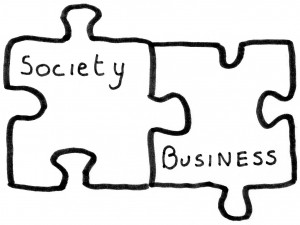Shared Value: what is that?
Shared value is the idea that a company can boost its value by addressing social issues that directly relate to its business.
It’s more than just charity. Shared value looks at specific philanthropic issues that can increase profits while helping society.
The two gentlemen who coined the term, Michael Porter and Michael Kramer, identified three ways companies can create these shared value opportunities:
- Producing innovative products that focus on societal benefits.
- Creating a more efficient supply chain to reduce environmental impact.
- Building supportive of industry relationships within the company’s operating communities.
What Do Companies Get From Shared Value?
Yes, shared value helps companies to increase revenue and improve margins, but it also provides companies with the opportunity to build brand value. From helping employees understand the company’s purpose, to improving consumer perception of a company’s relevance, shared value solidifies the qualities that help strengthen brands. When a company uses shared value initiatives, they produce a brand that is able to promote choice, improve loyalty and ultimately boost value.
In Canada, some major companies are taking advantage of shared value, and using the strategy as a tool to inform consumers of their business strategy and corporate citizenship efforts. These firms are stepping outside of the box and building brand value as a result.
What’s The Relevance of Shared Value?
Here’s one example for you.
It’s safe to say that the childhood obesity epidemic has reached Canada. Today, one in three children in Canada has an unhealthy weight, and most adolescents do not outgrow the problem by the time they become adults. If the trend were to continue, two-thirds of Canadians will be overweight by 2040. Two years ago, Canadian Tire launched a national advertising campaign to bring greater awareness to childhood obesity. It encouraged families to embrace sports and outdoor activities to maintain a healthy, active lifestyle. Canadian Tire has extended this effort beyond just TV ads, and founded its ‘Jumpstart’ initiative.
Two years ago, Canadian Tire launched a national advertising campaign to bring greater awareness to childhood obesity. It encouraged families to embrace sports and outdoor activities to maintain a healthy, active lifestyle. Canadian Tire has extended this effort beyond just TV ads, and founded its ‘Jumpstart’ initiative.
In 2005, Canadian Tire founded Jumpstart, which enables kids from low-income families to participate in sports by helping to cover all of the associated costs. These varied and combined efforts clearly enhance the brand’s relevance by increasing an engagement in sport, and inevitably promoting health and well being amongst Canadians.
What Does Clarity Have To Do With It?
One of the most crucial aspects of a brand is clarity. Every firm needs to be 100% clear on what the brands stands for, so its employees can properly promote, engage and deliver on its promise.
It’s been shown that companies with highly engaged employees significantly benefit, and often see an increase in all performance indicators (profitability, productivity, customer loyalty, and quality).

MEC (Mountain Equipment Co-op) is a perfect example of brand clarity. The Canadian brand clearly outlines its purpose and motivates employees accordingly. Anne Donohoe, the CMO, states simply, “Our mission is to inspire Canadians to be active outdoors.”
That being said, in order to fulfill this clear-cut mission, the company understands it has to go beyond providing the equipment. MEC has committed to conserving Canadian outdoor spaces, which are the lifeblood of the country. The company’s has shown its commitment by working with local communities and outdoor industry associations, while also working to achieve its five-year business and sustainability strategy.
By building supportive industry connections that create and develop opportunities within its specific market, and by making sure its employees understand the brand’s purpose, MEC does a great job of capturing the key principle of clarity.





